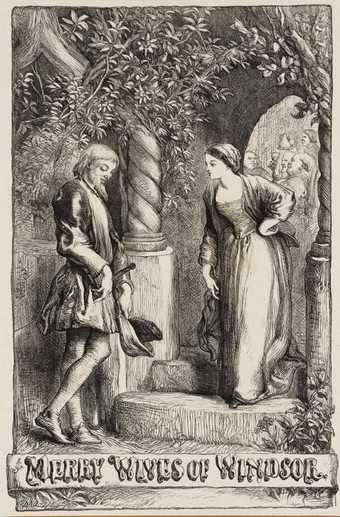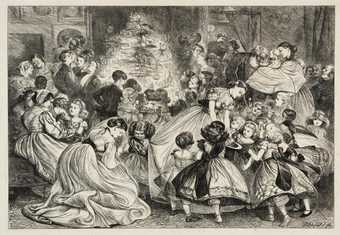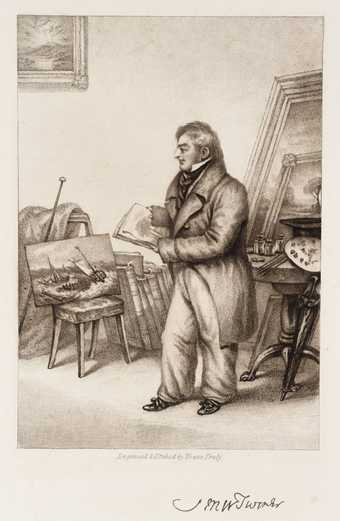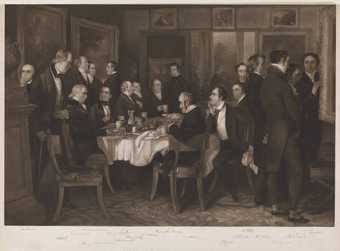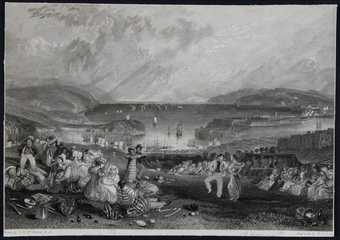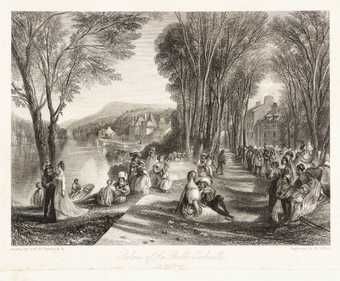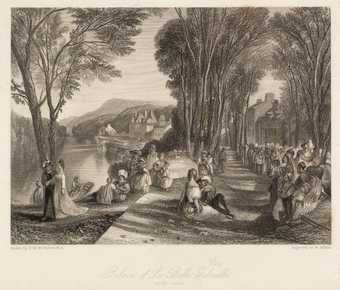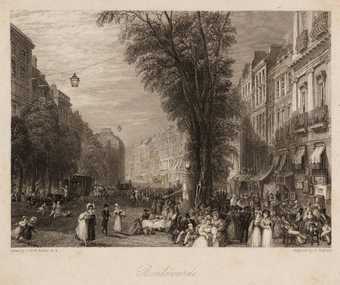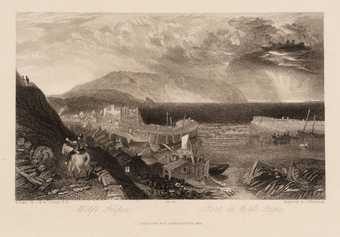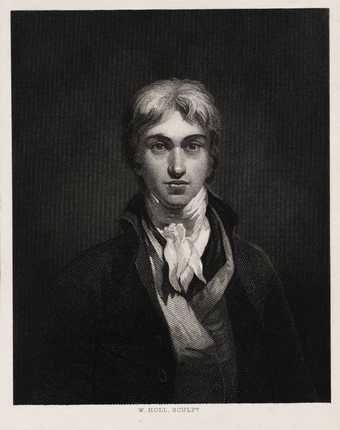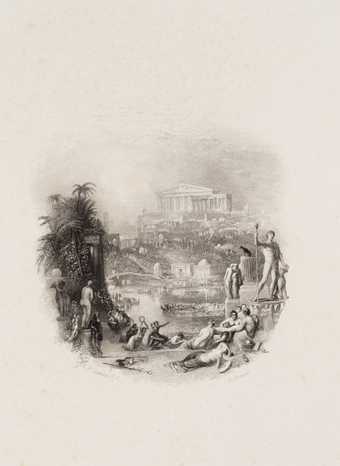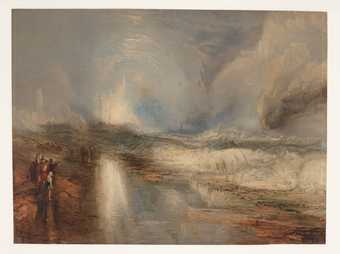
In Tate Britain
Prints and Drawings Room
View by appointment- Artists
-
Charles Hullmandel 1789–1850
After Count Alfred D’Orsay 1801–1852 - Medium
- Lithograph on paper
- Dimensions
- Image: 328 × 225 mm
- Collection
- Tate
- Acquisition
- Presented by Richard Godfrey in memory of Wilfred Yee Huie 1988
- Reference
- T05029
Display caption
This portrait vividly conveys Turner's rather unprepossessing appearance in his last years. He generally disliked having his portrait taken, which means that most of the surviving images of him were produced surreptitiously. Here he is shown at a social gathering, possibly at the home of Elhanan Bicknell, one of the collectors who continued to buy Turner's pictures in the 1840s. The allusion to the Fallacy of Hope under the image refers to the title of the ongoing poetic fragment from which Turner took quotations to accompany his exhibited pictures.
Gallery label, August 2004
Does this text contain inaccurate information or language that you feel we should improve or change? We would like to hear from you.
Catalogue entry
T05029 Portrait of J.M.W. Turner (‘The Fallacy of Hope’)
engr. Charles Joseph Hullmandel, pub.1851
Lithograph 328 × 225 (12 7/8 × 8 7/8) on India paper 411 × 263 (16 1/8 × 10 3/8); plate-mark 377 × 243 (14 7/8 × 9 1/2)
Engraved inscription: ‘The Fallacy of Hope’ below image at centre
Presented by Richard Godfrey in memory of Wilfred Yee Huie 1988
Prov:...; Richard Godfrey, by whom presented
The title of this portrait of the elderly Turner is an allusion to the subject's unpublished poem of that name, portions of which he had for many years attached to some of his exhibited pictures. D'Orsay's original drawing, in chalks, is in a private collection (A. Wilton, Turner in his Time, 1987, p.217, pl.286). A writer in the Athenaeum (17 March 1858, p.344) described it thus: ‘The best sketch of him [Turner] we know is Count D'Orsay's clever drawing of him at some soireé with a tea-cup in his hand’. According to a pencil annotation on an impression of the lithograph on the art market in 1992, the likeness was convincing: ‘Who would guess this to be a portrait of the great Painter J.W. Turner, but it is, and not unlike his general aspect at an Eveng Party’. Another pencil note on an impression in the National Portrait Gallery claims that D'Orsay's drawing was ‘said to have been touched by Landseer’ (R. Walker, Regency Portraits, 1985, I, p.512); and another impression is, as kindly pointed out by William Drummond, inscribed in ink in an old hand ‘Sketch taken by Landseer at a tea party’. The involvement of Landseer (presumably Edwin) cannot be discounted as he was certainly a friend of D'Orsay, but nor can it be proved.
Turner is seen at a conversazione held by his patron Elhanan Bicknell (1788–1861), collector and whaling entrepreneur. Bicknell regularly entertained artists at his house on Herne Hill, and Ruskin and E.W. Cooke were among those who met Turner there. These gatherings, which usually took place on Sundays, are delightfully recalled by Edgar Browne, the son of the artist Hablot Knight Browne (Phiz), in ‘Mr. Bicknell and his Friends’, the fourth chapter of his book Phiz and Dickens, 1913. D'Orsay's drawing evidently shows Turner in the ‘old drawing room’ at Herne Hill, for in the background are several of the watercolours which, as Browne described, were set directly into the rococo panelling of the walls: ‘The pictures in this room were all water-colours, and were not hung in the usual manner, but inset, the gilded mouldings acting as frames ... Turner's “Rivers of France”, if I remember rightly, served as decoration of the doors’. (See also G. Waagen, Treasures of Art in Great Britain, 1845, p.351.) J. Hogarth, the publisher of Hullmandel's lithograph after D'Orsay, had in 1845 issued John Pye's engraving (W.G. Rawlinson, The Engraved Work of J.M.W. Turner, II, 1913, p.206, no.622) after Turner's painting ‘Ehrenbreitstein’, originally commissioned by the engraver and bought by Bicknell the previous year (private collection; M. Butlin and E. Joll, The Paintings of J.M.W. Turner, 1984, no.361). For Bicknell's Turners, see P. Bicknell and H. Guiterman, ‘The Turner Collector: Elhanan Bicknell’, Turner Studies, vol.7, no.1, 1987, pp.34–44.
Several other derivations from this portrait type are recorded. A watercolour (260 × 165, 10 1/4 × 6 1/2) at the Lady Lever Art Gallery, Port Sunlight, ascribed to William Henry Hunt, was considered by Walker, who did not know of the chalk drawing, to be ‘possibly the original’ (Walker 1985, I, p.512); an impression of the Hullmandel lithograph in the National Portrait Gallery must be another state as it bears the different lettering ‘Count D'Orsay delt. Hulmandel lith’; D'Orsay himself etched a profile of the head only, on a slightly larger scale; a stipple vignette of the head and shoulders, also enlarged, formed the frontispiece of Thomas Miller's Turner's and Girtin's Picturesque Views, 1854; and see Charles Turner T04842 below for a stipple engraving published in 1852 and partly dependent on this composition.
Published in:
Tate Gallery: Illustrated Catalogue of Acquisitions 1986-88, London 1996
Explore
- interiors(2,776)
-
- domestic(1,795)
-
- living room(292)
- eating and drinking(409)
-
- drinking(267)
- party(106)
- actions: postures and motions(9,111)
-
- standing(3,106)
- man(10,453)
- individuals: male(1,841)
- arts and entertainment(7,210)
-
- artist, painter(2,545)
You might like
-
Sir John Gilbert The Merry Wives of Windsor, engraved by the Dalziel Brothers
published 1858–60 -
Arthur Boyd Houghton Uncle John with the Young Folk: ‘All Prizes and No Blanks!’ engraved by the Dalziel Brothers
published 1865 -
Charles Turner Portrait of J.M.W. Turner
1852 -
After John Doyle, engraver Charles Mottram Samuel Rogers at his Breakfast Table, engraved by Charles Mottram
c.1823 -
After Joseph Mallord William Turner Plymouth, Devonshire, engraved by W.J. Cooke
published 1832 -
After Joseph Mallord William Turner Palace of La Belle Gabrielle, engraved by W. Miller
published 1834 -
After Joseph Mallord William Turner Palace of La Belle Gabrielle, engraved by W. Miller
published 1834 -
After Joseph Mallord William Turner Boulevards, engraved by T. Higham
published 1835 -
After Joseph Mallord William Turner Wolf’s Hope, engraved by J.B. Kernot
published 1836 -
After Joseph Mallord William Turner Portrait of Turner, engraved by W. Holl
published 1859–61 -
After Joseph Mallord William Turner Statue of Turner (Turner Gallery frontispiece without lettering)
published 1859–61 -
After Joseph Mallord William Turner Statue of Turner (Turner Gallery frontispiece without lettering)
1859–61 -
After Joseph Mallord William Turner The Garden, engraved by E. Goodall
published 1839 -
After Joseph Mallord William Turner Rockets and Blue Lights, engraved by R. Carrick
published 1852 -
After John Jackson Portrait of James Ward, engraved by James Ward
?c.1835

